Aspect Energy creates ‘wow’ factor for its new headquarters.
No one knows exactly what the corporate offices of tomorrow will look like as the novel coronavirus (COVID-19) pandemic continues to upend any space in which people are expected to work and collaborate. However, the managers of Aspect Energy, an independent exploration and energy investment company with offices in Houston TX, Denver CO and Budapest, Hungary, knew what they wanted their new headquarters offices to look and feel like. The streamlined, cool-grey hallways and offices in the newly constructed, 18,000-square-foot build-out in downtown Denver are carefully countered with dollops of pastels and beiges on furniture and carpeting, with everything drawn together by black, slate-like floors.
It’s the audio and video endpoints throughout, however, that do the most to lend the space its sense of purpose—and they do so without interrupting the aesthetic flow. Videowalls that are composed of Planar’s third-generation, 65-inch Clarity Matrix displays give Aspect Energy’s staff geologists the ability to drill down into 4K-resolution satellite images, which are delivered over a variety of contentdeliver y platforms. Meanwhile, audio delivered via QSC’s Q-SYS processor is completely intelligible within potentially echoic glass-walled offices and meeting rooms; moreover, when the workday has concluded, audiophile Sonance speakers are just as accommodating for end-of-day kick-back music.
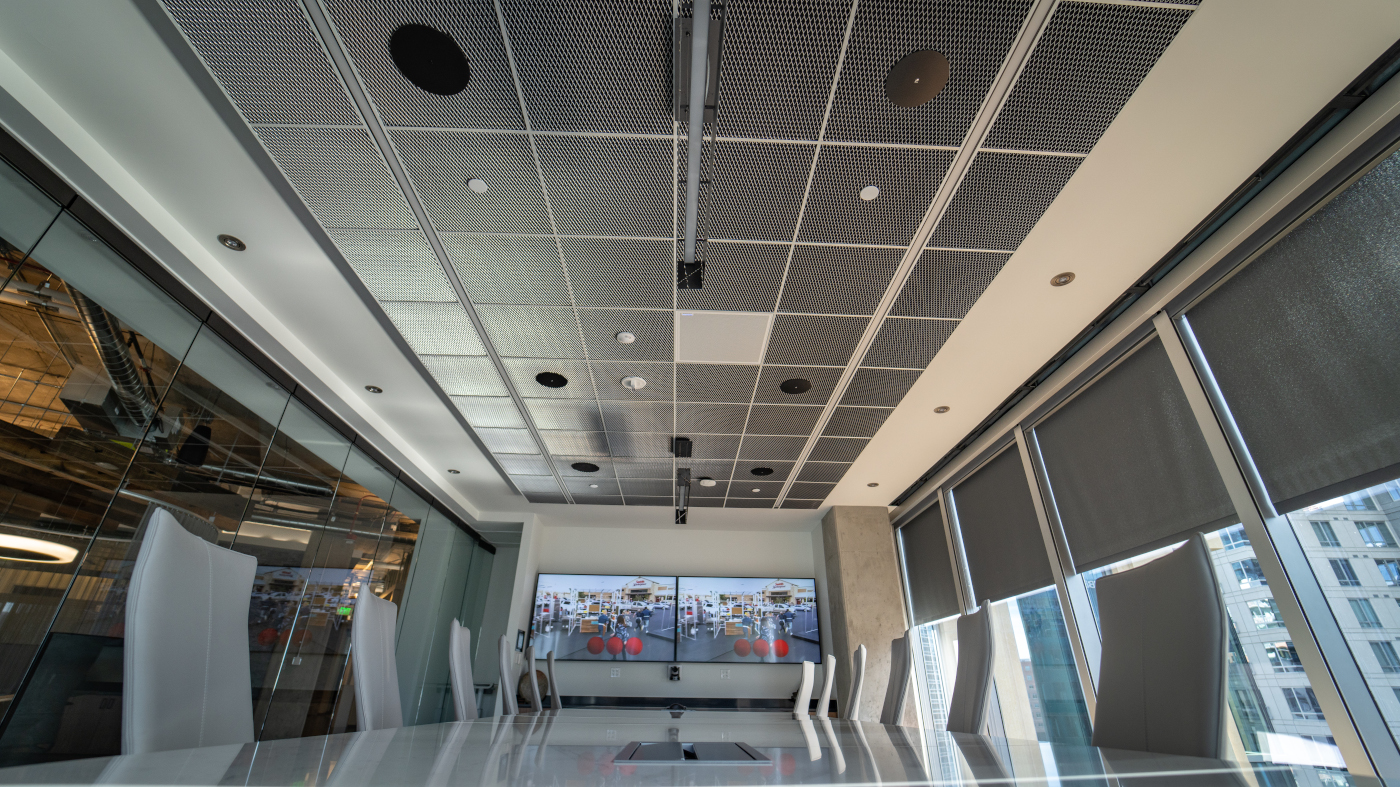
“[The client’s] embrace of technology is complete,” affirmed Tyler Bogart, VP of Sales at Logic Integration, the Denverbased AV integrator on the project, which wrapped up this past January. “They wanted the entire office space to be state of the art throughout, but it both had to be highly functional and [had to] provide a real ‘wow’
factor for visitors.”
Bogart continued, “What’s interesting is that they wanted every aspect of the office’s designs to incorporate technology, as well as [design] elements of the oil-and-gas industry.” For example, a reception desk is made from steel parts from an oil-drilling rig. Crestron control panels and Planar displays seem almost to float on walls and above custom room sideboards; meanwhile, Shure microphone arrays are suspended from open ceilings next to light fixtures and Sonance pendant speakers so that every endpoint appears to align with a larger aesthetic intent. “It’s all nicely integrated,” Bogart affirmed. “We were there to make sure the AV systems also fit perfectly.”
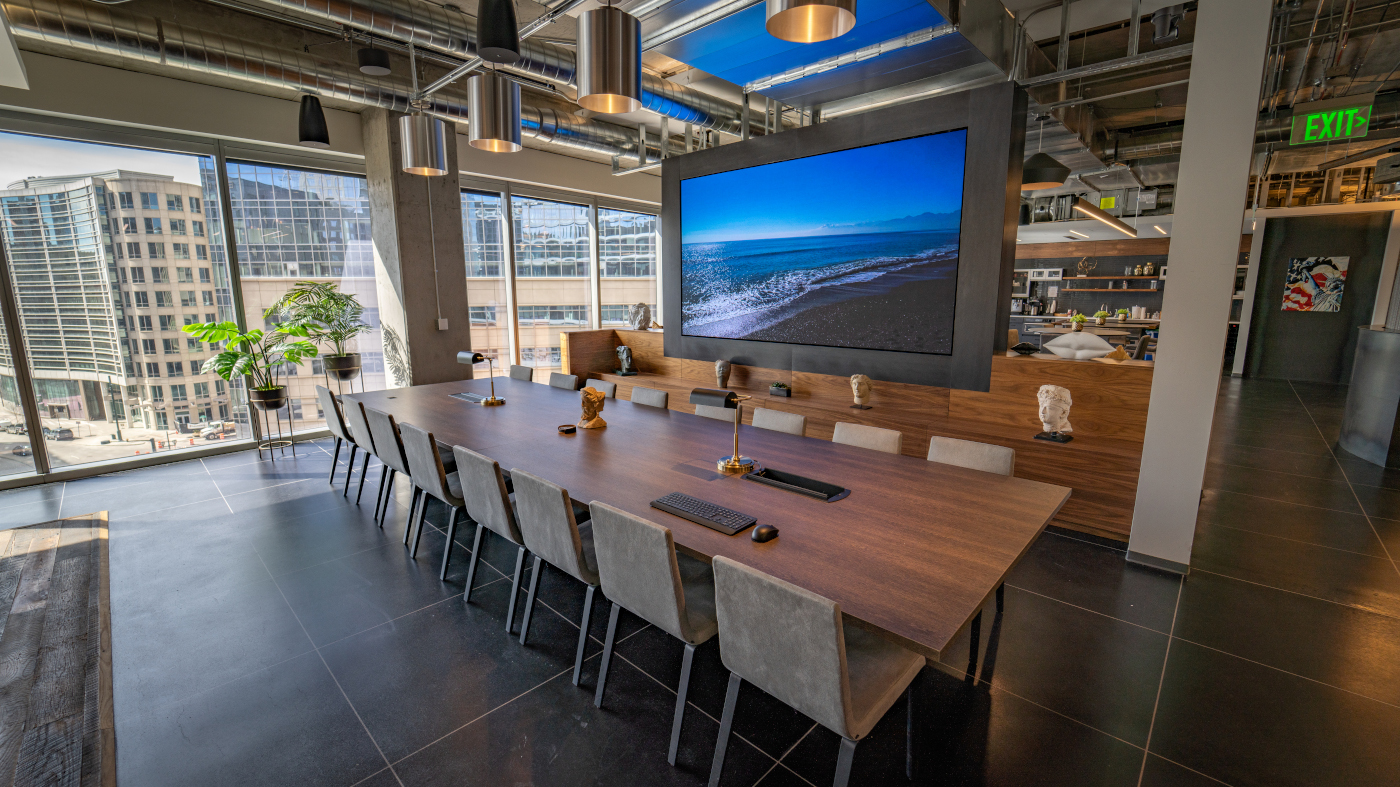
A Range Of Rooms
Room types are various, but all are AV outfitted. Huddle rooms seat four around a desk; a Planar 65-inch display at one end is fitted with a Huddly IQ camera and topped with a Crestron Mercury tabletop UC videoconference system (with built-in wireless content sharing). Conference rooms, which seat as many as 14 people, boast a pair of Planar 65-inch screens that nearly fill one wall. Two specialty rooms, used for exacting visual work that company geologists and other experts do, are fitted with videowalls composed of the new 4K Planar 65-inch Clarity Matrix G3 displays in a three-by-two configuration. Interestingly, most of these spaces also have either conventional artwork on the wall or have their displays equipped to run loops of digital modern and classical artwork. This is similar to what’s on the displays in the office’s reception and other lounge areas, emanating from a BrightSign XT244 media player.
The term “lounge”—the specialty rooms are dubbed the Geo Lounges, whereas other rooms are named for various Aspect Energy well sites globally—turns up often in conversations. This underscores an attempt, via the office design, to soften the= inherently rough edges of the petroleum-exploration industry. Chairs are comfortable, and a digitally controlled electronic fireplace sets the mood in a common area. Even more eye-catching is a five-by-five, 1.5mm-pixel-pitch direct-view-LED videowall that can be used as an informal videoconferencing tool. “There’s a surprisingly relaxed ambience in this office,” Bogart attested. “That’s on purpose, because it’s a very high-pressure business. That’s why we wanted to make sure the AV, such as the Crestron control systems, [would be] as easy to use and intuitive as possible.”
Shannon Garcia, Logic Integration’s Field and Project Engineer on this job, pointed out that the Geo Lounge’s six-panel (three by two) video displays are connected to the office complex’s large (35’x12′) rack room by Liberty AV multimode fiber cabling that extends nearly 250 feet to the lounges and delivers 4K image resolution. There are four cables per display. (The rack room holds the processors for the Crestron, QSC and other core systems.) More than 15,000 feet of Cat6 cabling carries the rest of the office’s video and control data, with another several thousand feet of speaker wire for the office’s distributed audio. “It’s pretty impressive—the resolution they can get on those displays over fiber,” Garcia commented, noting that the Planar thirdgeneration displays are used throughout because of their high level of detail.
An aside: Using a brand new product can put a project on the cutting edge, but it can also have its drawbacks. Garcia recalled that a power supply in one of the new Planar Clarity Matrix G3 MX65U-4K displays that compose a Geo Lounge’s videowall failed shortly after the wall was installed. With no original equipment manufacturer (OEM) replacement parts available, the crew had to wait for another display of the same model to be built and shipped to the job site. Planar bills the unit as the first LCD videowall solution on the market to embed advanced video processing directly into the product. “The only solution was a completely new product,” Garcia acknowledged. “The product is great, and this is a very showcase project, so it’s a good fit. It’s just a risk you take when you want to be at the [cutting] edge of technology.”
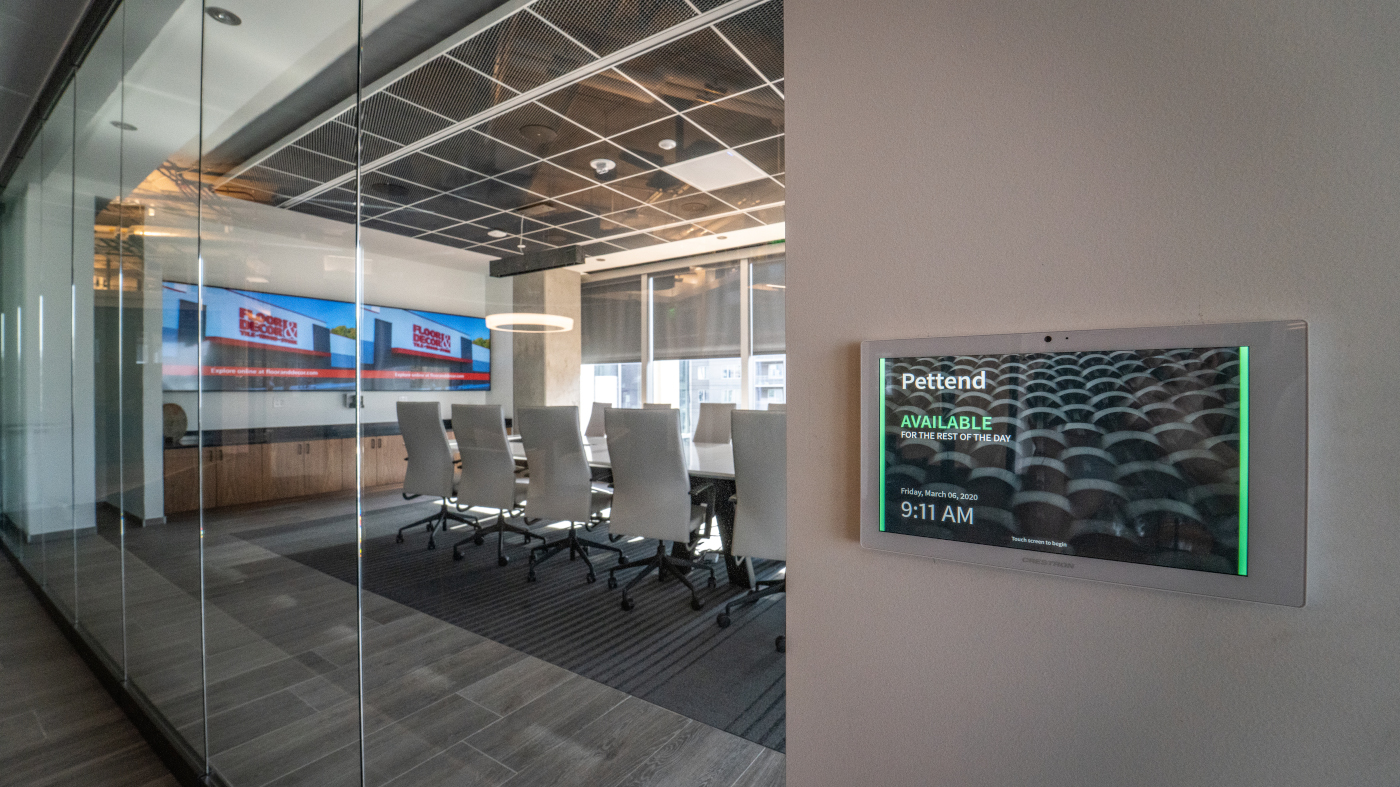
DSP To Solve Acoustical Challenges
All those hard, parallel surfaces in the office complex could have spelled acoustical trouble, impeding intelligibility during videoconferences in rooms bounded by floor-to-ceiling glass, sheetrock walls and hard-surfaced floors. That was not the case, however. As has increasingly been happening in recent years, absorptive-material solutions instead gave way to electronic fixes. Specifically, Logic Integration used the QSYS digital signal processor to ring out the rooms and deployed pendant speakers to put sound on seating areas and keep it off reflective surfaces. The integrator also adjusted the lobar parameters of the ceiling array microphones to focus on specific areas, using the up to eight steerable lobes in three dimensions on the Shure MXA910W array; this fine-tunes the position of each lobe in real time.
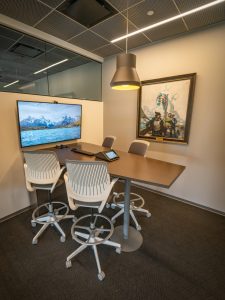
“Using electronics to deal with acoustical issues is relatively new for us, [as well as] for a lot of integrators,” Garcia remarked. “In the past, we’ve leaned on absorptive-type acoustical treatments to deal with reflections. However, the [aesthetic] considerations of this space were so meticulous and specific in terms of how they wanted the space to look [that] there wouldn’t have been much we could have done in terms of traditional treatments.”
The process involved Logic Integration’s Field Engineer, Luke Smith, sweeping the room with a broadband tone generator, looking for each room’s frequency profile. Then, the integrator applied equalization—mostly subtractive, and with a fairly light touch—to smooth out bumps in the response profile.
A somewhat more challenging part of the process occurred in the Geo Lounges. The larger videowall displays generated more heat, which, in turn, activated the heating, ventilation and air-conditioning (HVAC) system more frequently; the HVAC produced a mid-high-frequency masking effect that could impede speech intelligibility. The integrator remedied that by using a noise-gate function on the Q-SYS processor, which is used to either pass or attenuate audio signals based on the root-meansquare (RMS) level of the input signal. (If the signal is above the specified threshold, it’s passed un-attenuated; if the signal is below the threshold, it’s attenuated by the amount specified by the depth control.)
According to Smith, “You can use the gate to prevent open microphones and other types of inputs from introducing unwanted sounds into your system.”
Garcia added that sound was a focus throughout the office complex. The open-concept office style encourages give and take between employees in huddle rooms and other conference spaces, whereas engineers and geological specialists made clear that they would prefer their workspaces to have as few auditory distractions as possible. “Pendant speakers were important for achieving that—for keeping sound from the distributed system to areas where it was wanted,” Garcia explained. He added that Logic Integration used software from QSC’s EASE library to predict speaker locations and volume levels.
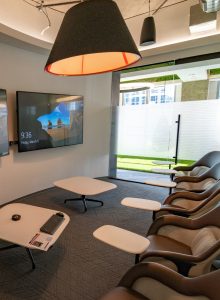
Throwing A Curve Wall
On the video side, most display mounts were a variety of Chief products. The Geo Lounge displays, however, had to accommodate the room’s curved front wall. “So much of the rest of the office [architecture] is very straight, so we wanted to maintain the curvature of the wall with the displays,” Garcia stated.
Kimball Hanny, Logic Integration’s Project Manager on the job, described it as “putting a non-curved videowall and mount on a curved wall. We had to create a truly custom mount.” The process involved taking lengths of Unistrut channels out to the warehouse loading dock at Logic Integration and slowly and carefully bending them across the rollers used to move heavy equipment between trucks and the warehouse. “We had templated the curve using cardboard, but, considering the tight timeline we were working under and the cost of custom fabrication, we instead saw that we could achieve the same result if we rolled the Unistrut piece by piece, inches at a time, over the rollers,” Hanny explained. “That created the backbone of the curved mount, and it worked perfectly. It really shows the ingenuity of our people in the field, because this was definitely not a copyand-paste project!”
The single biggest concern, according to Garcia, was bandwidth. The new offices’ huddle rooms use Zoom as a backbone that extends from videoconferencing to phone calls; meanwhile, the conference rooms make available codecs that are more typically corporate, such as Microsoft Teams. “It’s very much a multi-platform office for videoconferencing,” Hanny affirmed. “In the conference rooms, it’s whatever particular platform the host wants to use, as long as it’s a secure format. We gave them the flexibility to use what they prefer in those rooms, and there are several owner-furnished systems in the racks.”
In all cases, it was essential to achieve and maintain the highest resolutions of audio and video possible. That meant constantly testing to broadband signal strength, supplied by Comcast, during the installation and integration period, Garcia added.
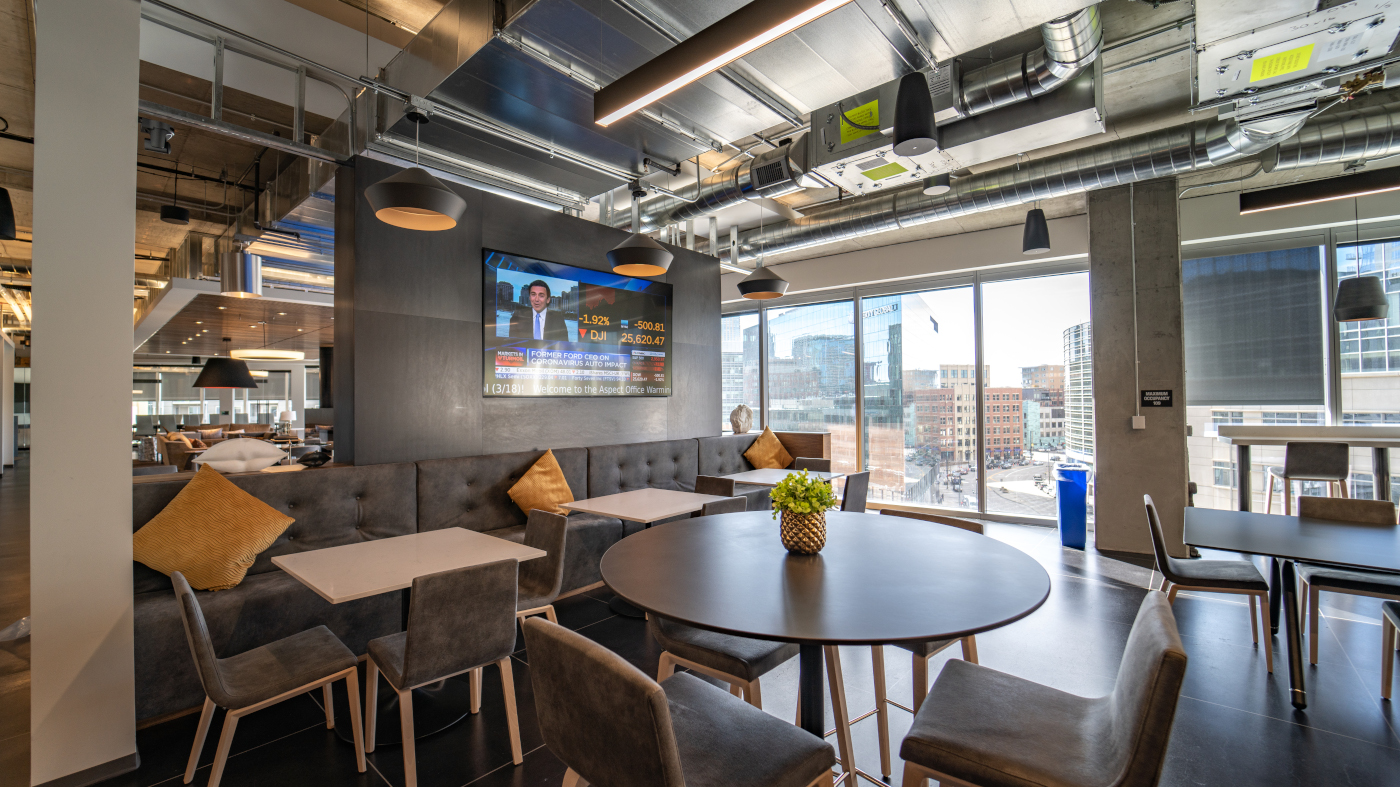
Network Challenge
Most all of the AV system’s elements in the office complex are on a segregated AV network. Smith pointed out that, as more audio and video endpoints—from videoover-IP and pan-tilt-zoom (PTZ) cameras to ceiling array microphones—are designed to be used that way, networks are going to struggle to manage point-to-point communication without proper configuration. “This was one of the larger-scale Crestron NVX VoIP deployments we’ve done,” he said. “And once we began putting all the video streams, microphones and other endpoints on the network, the challenge was getting them to cooperate with each other and not create a storm of multicast traffic.” Managing a concatenation of various AV endpoints involved using a layer 3 switch in order to maintain control and stability at the many endpoints. Smith said that the application of the Internet Group Management Protocol (IGMP) was critical for this.
“We could have just plugged everything into the network and let the system do its own device discovery and communication,” Smith said, “but, with more network-managed devices, this quickly becomes a problem.” He added, “Instead, we preprogrammed discovery by managing the traffic between ports within the Cisco SG series
switches. That means we could point devices to each other instead of having them just waiting to be grabbed by the system, thus creating a mess of directionless data.
Without management, we have seen Crestron processors literally disable their network ports, for example.”
So as further to add headroom and efficiency to the network, the integrators created a managed subnet, using multiple Cisco switches, for many of the streaming video signals. “That let us segregate and separately configure the video streams through the switches and keep [them] from interfering with other, less-network-heavy devices like touchpanels, USB hubs and shade controls,” Smith added. “We’ve learned to do this because of all the service calls we started getting as AV has become more network reliant in recent years. They’re getting overwhelmed with traffic.”
Smith continued, “We’re at the point where manufacturers are pushing more and more of their devices onto the network, and some of them are notorious for being problematic with multicast management and clock-master prioritization.” He conceded, “I mean, it can be great—it seems like you can just run category cable everywhere. But with so many devices now, you have to take it a few steps further. You have to configure the switches for the traffic that’s going [to be generated].”
The Aspect Energy project wrapped up just weeks before the business shutdowns that COVID-19 caused. Hanny recalled that, at that point, there were a few punch-list items and some minor programming left to do. “This project missed that moment,” he said.
As for the future of office-environment AV in a world after COVID-19? Hanny offered a succinct conclusion to reflect the pervailing uncertainty, saying only, “Interesting….”
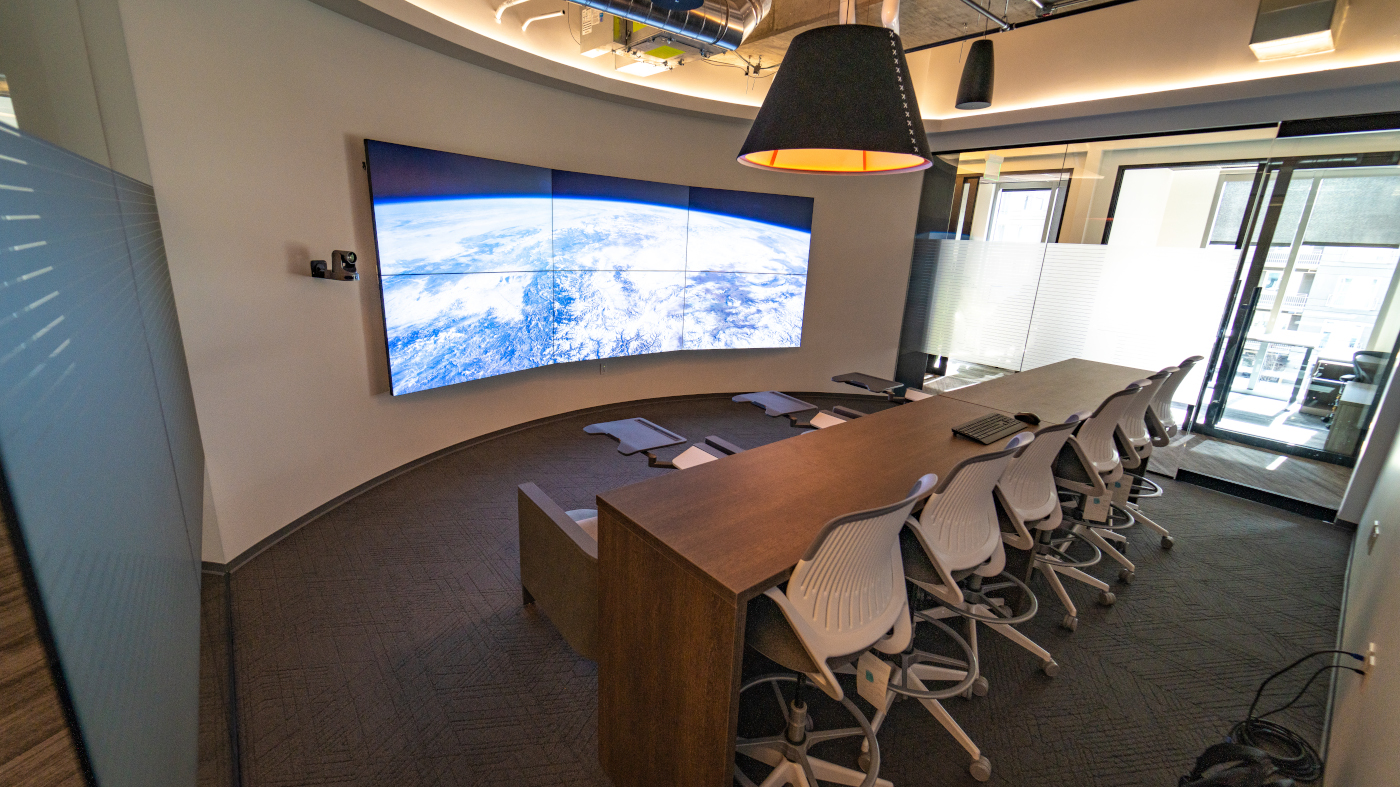
EQUIPMENT
2 Araknis Networks AN-ACC-SFP-MMF-350 multimode fiber small form plugs (SFPs) w/LC connectors
1 Autonomic AU-MMS-3E music streamer (3 audio streams)
1 BrightSign XT1144 expanded I/O player
1 BrightSign XT244 standard I/O player
4 Chief CSMP9X12 Series 9″x12″ component storage panels
2 Chief CSSMP15X10 Proximity component storage panels (sliding)
2 Chief LTM1U large Fusion micro-adjustable tilt wall mounts
4 Chief XTM1U x-large Fusion micro-adjustable tilt wall mounts
2 Cisco SG350X-48MP 48-port gigabit PoE stackable managed switches
2 Crestron CCS-UC-1-AV-PLUS Mercury tabletop UC videoconference systems w/professional cameras
2 Crestron CCS-UCA-SMK swivel-mount kits for CCS-UC-1-AV-PLUSes
4 Crestron CEN-GWEXER infiNET EX network and ER wireless gateways
1 Crestron CNPWS-75 Cresnet power supply (75W)
1 Crestron CP3 3-Series control system
3 Crestron DMF-CI-8 DigitalMedia card chassis for DM-NVX-350C (8 slots)
3 Crestron DM-NVX-350C DM NVX 4K60 4:4:4 HDR network AV encoder/decoder cards
6 Crestron DM-NVX-D30 DM NVX 4K60 4:4:4 HDR network AV decoders
7 Crestron DM-NVX-D30C DM NVX 4K60 4:4:4 HDR network AV decoder cards
5 Crestron DM-NVX-E30 DM NVX 4K60 4:4:4 HDR network AV encoder
14 Crestron DM-NVX-E30C DM NVX 4K60 4:4:4 HDR network AV encoder cards
2 Crestron HD-EXT-USB-2000-C 4K HDMI and USB over HDBaseT extenders
2 Crestron HD-MD4X1-4K-E 4×1 4K HDMI switchers
4 Crestron HD-RX-101-C-E DM Lite HDMI over Catx receivers (surface mount)
4 Crestron HD-TX-101-C-1G-E-W-T DM Lite transmitters for HDMI signal extension over Catx cables, wallplate (white, textured)
5 Crestron TSS-10-W-S 10.1″ room-scheduling touchscreens (white, smooth)
4 Crestron TST-902 8.7″ wireless touchscreens
4 Crestron TST-902-DSW wall docks for TST-902 touchscreens
4 Crestron TST-902-DSW-BB wallmount back boxes for TST-902-DSW wall docks
3 Crestron TSW-760/1060-MSMK-B-S multisurface mount kits for TSS-10s (angled, black, smooth)
15 Extron ASA 121 passive audio summing adapters w/RCA inputs and unbalanced outputs
6 Legrand EB1 blank panels (1RU, steel, flanged)
2 Legrand EB2 blank panels (2RU, steel, flanged)
2,700 Liberty AV 16-2C-P-WHT16AWG 2-conductor plenum-rated cables
200 Liberty AV 24-4P-L6-EN-BLU 1,000′ reels of Cat6 U/UTP EN Series 23AWG, 4-pair unshielded cable
9,250 Liberty AV 24-4P-P-L6ASH-YEL 1,000′ Cat6a F/UTP EN Series 23AWG, 4-pair shielded cables
6,600 Liberty AV 24-4P-P-L6-EN-BLU 1,000′ reels of Cat6 U/UTP EN Series 23AWG, 4 pair unshielded cable
1,000 Liberty AV 4B50125OM3P 4-fiber-breakout OM3 multimode Cleerline SSF indoor/outdoor plenum fiberoptic cables
1 Liberty AV custom rack service plate
2 Liberty AV E2-HDSEM-M-01 3′ commercial-grade HDMI cables w/Ethernet
5 Liberty AV E2-HDSEM-M-01.5 5′ commercial-grade HDMI cables w/Ethernet
29 Liberty AV E2-HDSEM-M-02 6′ commercial-grade HDMI cables w/Ethernet
2 Liberty AV E2-HDSEM-M-03 10′ commercial-grade HDMI cables w/Ethernet
5 Liberty AV E2-HDSEM-M-04 12′ commercial-grade HDMI cables w/Ethernet
2 Liberty AV E2-HDSEM-M-05 16.5′ commercial-grade HDMI cables w/Ethernet
300 Liberty AV RG58-CMP-WHT microwave and wireless RF195 RG58 solid dual-shield plenum cables
3 Liberty AV SSF-LC-MMFPC-10 10-pack multimode LC/FPC field-assembly plugs
3 Mersive Solstice Pod turnkey wireless presentation solutions
3 Mersive SP-8301-E Solstice Pod power supplies
2 Middle Atlantic LBP-2A lace bars (2″ offset, L-shaped, 10 pieces)
2 Middle Atlantic LBP-4A lace bars (4″ offset, L-shaped, 10 pieces)
1 Middle Atlantic MRK-4431-AV MRK Series rack (44RU, 31″D)
2 Middle Atlantic SignalSAFE IEC-240X1 standard power cords
1 Middle Atlantic SSL sliding rackshelf (1RU, laminated)
2 Middle Atlantic U1V utility rackshelves (1RU, 10.4″D, vented)
7 Middle Atlantic U2V utility rackshelves (2RU, 14.75″D, vented)
6 Planar Clarity Matrix G3 MX65U-4K LCD videowall displays (3×2)
1 Planar Simplicity Series SL5564K 55″ 4K LCD display
1 Planar Simplicity Series SL6564K 65″ 4K LCD display
5 Planar Simplicity Series SL8664K 86″ 4K LCD displays
1 Planar TVF Series 5×5 fine-pitch LED videowall display (1.5mm)
3 QSC CIML4 mic/line analog input cards
1 QSC COL4 analog line output card
1 QSC CXD8.4Q power amp w/DSP
8 QSC I/O-USB Bridge peripherals
5 QSC PTZ 12×72 IP-based conference cameras w/native streaming w/the Q-SYS platform
1 QSC Q-SYS Core 510i integrated processor
2 SanDisk Ultra 64GB microSDXC UHS-I cards w/adapters
3 Shure MXA910W ceiling array mics
2 Shure SLX24/SM58 wireless systems w/SLX2/SM58 handheld transmitters
2 Shure UA221 passive antenna splitters
2 Shure UA8 1/2-wave dipole antennas
4 Shure UA834WB in-line antenna amps for remote mounting (470MHz to 902MHz)
2 Shure UABIAST in-line power adapters
1 SnapAV OVRC-300-PRO OvrC Pro lifetime license and gigabit hub
12 Sonance PS-C63/P63 BLACK Professional Series 6″ round replacement grilles (2 packs, paintable black)
6 Sonance PS-C63RT Professional Series 70V/100V/8Ω selectable in-ceiling speakers
14 Sonance PS-C63RTLP Professional Series 70V/100V/8Ω selectable, low-profile in-ceiling speakers
16 Sonance PS-P63T 70V/100V/8Ω selectable pendant speakers
6 Tripp-Lite B203-101-PNP 1-port, plug-and-play USB 2.0 over Cat5 Cat6 extender kit
1 WattBox KIT-WB-700-IPV-12 IP power conditioner w/OvrC home and faceplate kit
1 WattBox WB-600-FP rackmountable modular faceplate display
1 WattBox WB-700-IPV-12 IP power conditioner w/OvrC home and faceplate kit
1 WattBox WB-800VPS-IPVM-18 IP vertical power strip and conditioner w/individually controlled and metered outlets
1 Wirepath WP-PC-FBR-DMM-LCLC-1 SSF duplex multimode OM3 patch cord (1m)
List is edited from information supplied by Logic Integration.
To read more from Sound & Communications, click here.